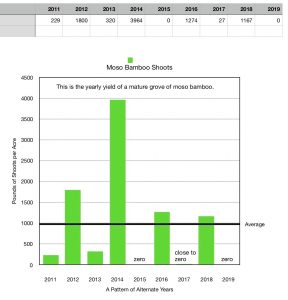Farmers and land owners call me (Daphne Lewis) for information. They have been approached by companies that tell them they can make a profit quickly by planting bamboo.
The American Bamboo Society created the document below to tell their experience about farming bamboo.
MOSO & ASPER BAMBOO
February 2018
Approved by American Bamboo Society
Recent years have seen an interest in growing bamboo as a cash crop. The American Bamboo Society is in general supportive of such ventures. However, we have seen some companies giving unreliable information to prospective farmers of bamboo. We advise all prospective bamboo farmers to be cautious when considering opportunities that promise quick and substantial profit.
Timber bamboos, such as moso (Phyllostachys edulis (syn. P. pubescens ), can be finicky growers. Small moso plants can be killed by hard freezes. Small moso plants do not grow well in full sun. Mature moso forests rarely have 6 inch canes. Three to four inch canes are more common. It will take 10 years for the grove to produce four inch canes. Those canes are not hardened enough to harvest as poles until four more years pass. Sales of bamboo shoots from a moso planting in four years is not realistic.
The American Bamboo Society supports the growing of many timber bamboos as a farm crop, not just moso bamboo. Bamboo grown as a farm crop provides numerous benefits to the farm in addition to income.
Bamboo shoots for food
Bamboo poles for crafting, wood, fiber
Evergreen leaves for fodder, year around carbon sequestration, bamboo tea.
Bamboo groves for noise and dust abatement
Bamboo groves for windbreaks and wildlife habitat
Bamboo groves for beauty
Rhizomes and roots for soil conservation, waterways buffer, recycling of manures
Rhizomes for nursery propagation
Divisions for nursery propagation and landscape sales
Moso bamboo ((Phyllostachys edulis (syn. pubescens)) is the largest of the temperate bamboos. In China, it is the source of fiber for textiles, wood for laminated products such as flooring and plywood, and, bamboo shoots for food. Shoots are sold fresh, dried, and pickled.
Members of the Southeast Chapter of the American Bamboo Society have grown and attempted to grow moso bamboo over many decades. We note the following characteristics of moso.
Moso needs summer warmth and winter chill. (Dies out in Florida, not the panhandle.)
It does not like sandy soil. (Dies out in Savannah, Georgia.)
It will not spread into saturated soil. (Observation of Robby Russell’s moso in middle Georgia which is 25 years old.)
Moso matures more slowly than other large bamboos. (First shoot harvest of North American Bamboo Solutions in Unadilla GA will begin in 2019 at year eight. Irrigation was not available the first year.)
It produces best with summer irrigation and ample compost and mulch.
Moso yields new shoots in alternate years. See graph from data generated by Bamboo Farming USA.
Small moso plants (young seedlings) have large leaves that need protection from sun.
Moso shoots when soil temperature reaches 58-60°F usually in early April. Plant where soil warms quickly in spring for maximum shoot production.
Manage a moso grove with fewer canes per acre for shoots (1800 to 2000); more, for poles.
Moso is an alternate year crop because it changes its leaves in alternate years.
Moso bamboo is usually grown from seeds or from divisions of seedlings. Seedling variability means that you can not be sure that the mature plant is as large as you expect.
Young bamboo plants are very susceptible to residual herbicide in soil after field clearing.
There is no established support system for farmers of bamboo. Extension agents know little. No current mill operation buys poles and turns them into mulch or fiber or plywood or feed. No food processor buys bamboo shoots for canning or freezing or drying. You must create your own market, your own value-added product.
To summarize, most timber bamboos takes years to mature (except P. vivax which gets big fast). Moso probably matures in 12 years in favorable conditions. Income from a mature grove has not been demonstrated in the United States. (Except Dain Sansome’s P. vivax in Oregon which produces shoots every spring which are sold to local people who harvest them.)
Moso is an elite bamboo, much admired. Dendrocalamus asper is another elite bamboo, much admired. D.asper is a tropical bamboo adapted to humid heat. D.asper will grow well as a farm crop in USDA hardiness zones 10 and 11. In Florida, this zone includes areas south and east of Lake Okeechobee as well as some coastal areas just north of the lake.
- asper can be grown as an ornamental plant (not a farm crop) in USDA hardiness zone 9b, recovering nicely after light freezes. However, because of the inevitable low temperature setbacks in 9b, it will continually struggle to reach its full production potential. Zone 9b includes most of central Florida. The rest of Florida includes USDA zones 8a to 9a whereD.asper should not be attempted.
This is link illustrates zones by zip code or state: http://planthardiness.ars.usda.gov/PHZMWeb/
Note the alternate pattern of yearly shoot production.
This data is from a mature grove of moso grown in Central Georgia in zone 8a. The grove has no irrigation.